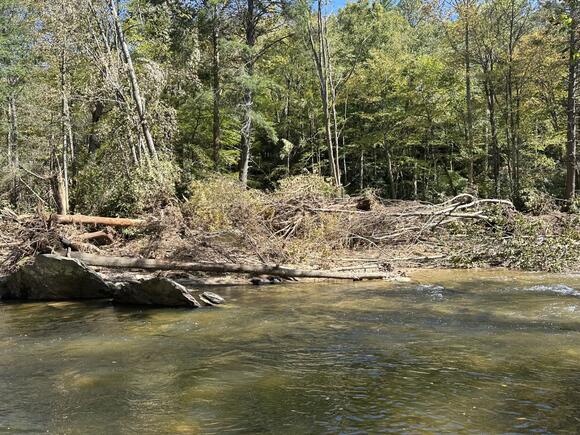
BOONE — Rivers swelled, trees fell and landslides engulfed mountainsides as the landscape of Watauga County radically changed when Hurricane Helene brought historic rain and wind to the area.
As support and recovery efforts continue across the region, assessments of the environmental damage have yet to account for the devastating effects Helene has had on the ecosystem.
“It is my personal perspective that this is going to be the most severe environmental disaster in the recorded history of this area. We’ve experienced nothing like this before,” said New River Conservancy Executive Director Andrew Downs.
The rivers and streams that run through the mountains are vital to the economy, recreation and identity of Watauga County. Throughout the storm, unprecedented water and debris swept through these areas, leaving a trail of environmental destruction.
Environmental organizations are just beginning to inspect the damage to the ecosystem.
“We’re just getting our minds around the human toll of this hurricane and the flooding, but the environmental toll is also staggering. We’ve seen drowned wildlife and habitat destruction along the rivers and watersheds, and widespread erosion and sedimentation,” Blue Ridge Conservancy’s Director of Communications Leila Jackson said.
Days before Helene, Boone and surrounding communities were struck with storms that filled up the natural sponges that typically absorb water before the full brunt of the storm made its way to the Appalachian Mountains.
“That set the stage for when the real part of the storm arrived,” said Dr. Bill Anderson, an App State hydrogeology professor. “There’s no storage or anywhere for that water to go but rush down our mountain valleys and get into the major streams and try to get out of here as quickly as possible.”
With nowhere to go, rainwater made its way into Watauga County’s rivers and streams, along with the houses, trees, asphalt, cars, and sediments that were destroyed and swept into the river.
“There’s all the materials, from tires to construction debris, that are in the river that are going to have a long-term impact,” Downs said.
On Sept. 27, the USGS sensor on the Watauga River measured a discharge rate of 32,300 ft3/s, about 1000x more than what was recorded just days before, and a height of 25 ft. Both readings were still climbing upward when the sensor broke during the storm.
As flood waters and materials made their way through river beds, they caused significant damage to the river banks, or riparian zones.
“Those natural filters that protected the river were wiped out, eradicated in many places, and those are going to need to be rebuilt,” Downs said.
These natural protection systems have been crippled by physical damage, and this has left the environment more susceptible to chemical and biological damage.
Along with the wreckage of buildings and roads, water likely picked up the toxic materials, pesticides and sewage it came in contact with.
“Who knows what kind of contaminants that we all have in our households for cleaning and so forth. Those are all in the streams now,” Anderson said. “When you’re out in the non-municipal areas, people have septic tanks, and I would guess that a number of those have been compromised or maybe completely inundated.”
Large amounts of pollution, toxicants and waste can cause a variety of problems for mountain ecosystems.
They can influence water and habitat quality, food availability, wildlife behavior and aquatic oxygen levels and disrupt natural cycles within an ecosystem. This can reduce wildlife’s overall rates of survival and affect systems that rely on healthy waterways.
“All other systems rely on water, you don’t have to overthink it,” Downs said. “Water isn’t a building block, it’s the building block.”
Contaminants can also cause dangerous algae blooms making it even more difficult for ecosystems to recover.
Over time, the rivers and streams will move some of these contaminants downstream and out of the region, but Helene’s timing means the scars left behind will take more time to heal and make natural and human communities more vulnerable as the ecosystem repairs.
With winter around the corner, areas where trees fell and landslides ripped apart soil and vegetation have little time for secondary succession, when new plants and grass recolonize disrupted ecosystems.
“We’re going to have a lot of barren areas throughout the winter,” Anderson said. “So when we do get rain, and we get quite a bit of rain throughout the winter, I think we’re going to be more prone to landslides and see more sediment in our streams.”
As the wreckage and debris from our communities begins to be cleared, unnatural levels of sediment in the water ways remain an issue.
Studies show that while sediment is a vital component of ecological functions when it exceeds natural limits, it can have a range of negative effects on aquatic ecosystems and act as a sink for contaminants.
“That’s going to compromise the environment and anything trying to live in those streams,” Anderson said. “Our mountain streams are cool and clear environments. That is what the animals that live in those environments have adapted to.”
In some areas, the rushing water created new pathways for runoff and altered the natural floodplain. Depending on the severity, this could cause increased erosion and flooding in areas where it was not typical.
“This is what streams do; that’s how they wear down our mountains, and they’ve been doing this for a very long time,” Anderson said.
The assessment of the environmental destruction caused by Hurricane Helene will only add to the total account of devastation.
 Local News
Local News

Comments / 0